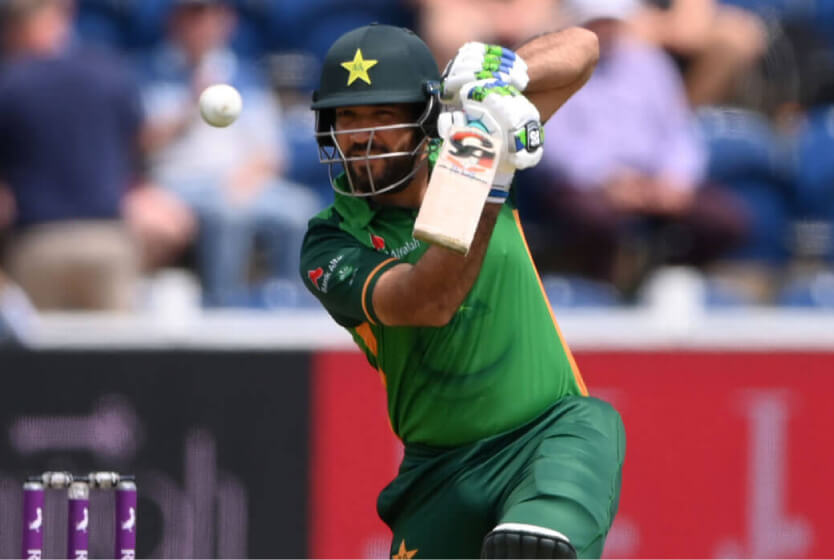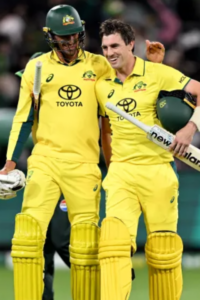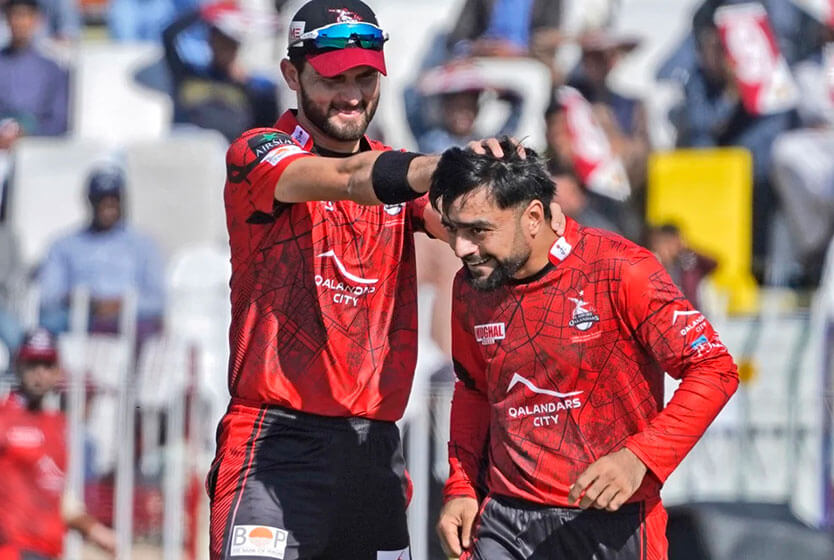
Sohaib Maqsood and Pakistan’s T20I Dilemma
The tall right-hander returns to the national side after a lengthy hiatus – but where does he fit in the lineup?
What makes a good T20 batsman? Since the start of T20 cricket in the mid-2000s, people have wondered how best to judge a T20 batsman. Is it through plain numbers: average and strike rate? That’s rarely the answer, though those figures do often tell a story. However, as T20 cricket has evolved, enthusiasts have begun to understand the importance of playing roles.
In Test cricket, opening the batting is hard. But the expectations are clear. Barring a few outliers, most teams want openers who can handle new ball movement and high-quality pace bowling. These may not even be the best batsmen in their respective teams, but they play a critical role in the progression of a match. The same applies to ODI batsmen, etc.
There are very few T20 batsmen around nowadays who can seamlessly transition to almost any role in a batting lineup. AB de Villiers, one of the greatest batsmen of all time, is perhaps the only one. Sohaib Maqsood, on the other hand, is a good but flawed T20 batsman.
From a purely technical point of view, the tall right-hander has struggled with his balance and footwork in the past. Simultaneously, he also had a habit of poor decision-making, leading to wrong shot selection – a flaw in his game he has readily accepted. He doesn’t hit the ball in the V much, preferring to hit it square or in front of square.
Yet, Maqsood has bags of ability as a batsman, particularly ball-striking ability. With the incredible wrist work and power he possesses, he could have perhaps achieved much greater heights in a better cricketing setup than Pakistan’s – where we have notoriously failed to develop batsmen. A shot from PSL 3 is etched in the memory, where Wahab Riaz bowled a fullish delivery on middle stump. Maqsood made a bit of room, and with one slight flick of the wrist, the ball flew over extra cover for an 80m six.
How Sohaib Maqsood Plotted a Comeback
At 32 years of age, the tall right-hander – who had once been compared to Inzamam-ul-Haq – went through a terrible rut. He had the worst year of his career in 2019, first struggling in PSL 4 and then failing to make an impact in the National T20 Cup later that year. Consequently, he was also ignored at the draft for PSL 5.
Perhaps realizing that he was in a rut and his career wasn’t really going anywhere, it appears that Maqsood adopted a change in mentality. Seeing the demands of T20 cricket and accepting that a batsman fails more than he succeeds is key to doing well in this format. You can’t score runs all the time unless you make a high volume of them (see: T20 anchors like Babar Azam). If that’s not your game, then make sure that when you do make runs, they really count. That’s what Maqsood did.
| Year | Inns | Runs | 50s | AVG | SR |
| Before 2020 | 105 | 2482 | 12 | 27.3 | 125.8 |
| Since 2020 | 25 | 837 | 9 | 38.0 | 159.7 |
In his first match of the 2020 National T20 Cup, he set the tone for what was to follow with a 25-ball fifty. He would eventually cap this off with a Player of the Tournament performance at the 2021 edition of the Pakistan Super League (PSL), earning a recall to the national side. Of the 19 Pakistani batsmen to have made 500+ runs during this period, none has a better strike rate than Maqsood. None hits boundaries as often as he does.
Best Strike Rates for Pakistani T20 Batsmen (Since 2020)
| Player | Avg | SR | BPB |
| Sohaib Maqsood | 38.0 | 159.8 | 4.15 |
| Azam Khan | 23.1 | 155.7 | 4.25 |
| Haider Ali | 25.1 | 148.1 | 4.77 |
| Khushdil Shah | 33.5 | 147.2 | 5.28 |
| Shadab Khan | 28.4 | 144.8 | 5.75 |
| Asif Ali | 20.8 | 142.7 | 5.32 |
| Kamran Akmal | 24.5 | 141.0 | 4.34 |
| Mohammad Hafeez | 39.4 | 138.4 | 5.47 |
| Shoaib Malik | 35.5 | 136.7 | 6.33 |
| Sharjeel Khan | 23.9 | 135.0 | 4.74 |
Batting Positions…
Here, we really need to go back to where we started this article, and that’s about playing roles. Each player in a T20 team has a particular role according to a regular scenario. The anchor needs to anchor. The strikers need to strike. Lower-order bats play short and impactful innings. That’s usually how it goes, though players need to be adaptable to changing circumstances.
Sohaib Maqsood’s T20 Positional Breakup
| Pos | Inns | Runs | 50s | AVG | SR | BPD | BPB |
| Open | 19 | 512 | 2 | 28.4 | 133.7 | 21.3 | 4.56 |
| 3 | 57 | 1808 | 14 | 37.7 | 134.7 | 28.0 | 5.43 |
| 4 | 32 | 775 | 5 | 25.8 | 133.6 | 19.3 | 5.58 |
| 5-7 | 22 | 224 | 0 | 13.2 | 116.7 | 11.3 | 8.73 |
Sohaib Maqsood, interestingly, made his T20 debut way back in 2005 – just days after his 18th birthday. However, he wouldn’t play again until the 2008/09 season. Here, he opened the innings. His scores read 39 (33), 44 (25), 59 (40), and 5 (5). Strangely, he wouldn’t play again until 2012 – where he continued to open the batting with varied results. Of course, when he was picked for Pakistan A in 2013, he was sent in to bat at #5 in the 15th over and recorded a failure. He returned to domestic cricket and continued to open.
Maqsood has batted 22 times at #5 or lower in his T20 career. 11 times for Pakistan, 8 times in the PSL, once for the A side – and TWICE in domestic cricket (out of 72 innings). Neither has he been able to score many runs on these occasions nor has he played short, impactful innings – what is usually needed from lower-order T20 batsmen.
The Importance of Entry Points
Over a large sample size, batting positions are useful. However, they don’t quite tell the whole story. Batting at #4 in a poor batting side prone to losing early wickets can be akin to opening. If a batting side opts for an ultra-aggressive approach, they may need an anchor in the middle order to stabilize the innings and bat through. Batting at the same position for a side with a strong and stable top order will necessitate more lower-order batting skills.
Sohaib Maqsood’s T20 Innings by Entry Points
| Entry Point | Inns | Runs | 50s | AVG | SR | BPB |
| Overs 1-6 | 81 | 2466 | 18 | 32.9 | 133.2 | 5.13 |
| Overs 7-11 | 30 | 628 | 2 | 26.2 | 130.8 | 6.86 |
| Overs 12-16 | 14 | 186 | 1 | 15.5 | 131.9 | 6.41 |
| Overs 17-20 | 5 | 39 | 0 | 19.5 | 156.0 | 6.25 |
| 10/10 Breakup | ||||||
| Overs 1-10 | 105 | 3004 | 20 | 32.0 | 133.2 | 5.37 |
| Overs 11-20 | 25 | 315 | 1 | 16.6 | 130.2 | 6.54 |
As the numbers show, Maqsood, throughout his T20 career, has mostly come in to bat during the powerplay. Usually, that’s either while opening or batting at #3. He also has a good sample size of coming in to bat in the post-powerplay phase. But… he rarely comes in to bat during the 2nd half of the innings. And when he does, he enjoys very little success.
Succeeding in the early overs and failing toward the back end perhaps shows that he’s more adept at playing the counter-attacking role, putting the pressure back on the bowling side as they look to take wickets. On the other hand, teams usually adopt a far more conservative approach toward the end of T20 innings, especially with bowlers looking to execute their defensive skills. Not all batsmen who can attack in the powerplay or early during an innings can do the same against defensive bowling.
Simultaneously, some batsmen are more capable of maintaining a high strike rate with controlled aggression and then increasing it as the innings goes on. On the other hand, they may struggle if they have to be ultra-aggressive from the get-go. That is what Maqsood’s numbers are hinting at so far.
The Structure of Pakistan’s T20I Side
Sometime in 2020, the management and Misbah-ul-Haq took stock of Pakistan’s batting problems in T20 cricket and came up with an apparent solution. After having tried to pair Babar Azam up with an aggressor for years (and failing to find someone who fulfills that role adequately), Team Pakistan appears to have gone for the dual anchor opening partnership, with Mohammad Rizwan stepping in. This is fraught with risk; if bowling teams can successfully contain their scoring areas, then they can shut the innings down.
To counter this, Pakistan’s top order generally functions with one of Babar or Rizwan adopting a slightly more aggressive role, according to whoever gets “in” on any given day. The mantra is that if one of them falls, the other one should look to bat through the innings. This ploy generally guarantees stability to the innings, with both Babar and Rizwan having a very high balls-to-dismissals ratio. However, this also means that the rest of the batting lineup has to be ultra-aggressive… and entry points, on average, leave the middle and lower-order batsmen with few resources (balls).
Average Entry Points for Pakistani Batsmen
| Entry Points | Overall | Since 2016 WC | Since 2020 |
| #3 | 3.4 overs | 3.5 overs | 3.5 overs |
| #4 | 7.4 overs | 9.1 overs | 9.5 overs |
| #5 | 11.1 overs | 13.4 overs | 14.1 overs |
| #6 | 14.5 overs | 16.5 overs | 17.1 overs |
| #7 | 17.4 overs | 19.2 overs | 19.5 overs |
Since Babar joined the Pakistan T20I side, entry points for the other batsmen have generally been later on in the innings. That’s not surprising, considering the number of balls he faces per innings on average. However, it also means that batsmen batting at spots such as #5 and #6 must have a certain set of skills. Pakistan’s dilemma is that very few batsmen in the country appear to possess the necessary skills to be effective in this role. What Pakistan would give for a batsman like Tim David…
Where Does Sohaib Maqsood Fit In?
A few days before his selection for Pakistan, Maqsood spoke to ESPNCricinfo. Here, he outlined his preferred batting position and the reasons for it.
“I always said that I am a top-order batsman, but I never got an opportunity in the PSL to bat higher until this [second] leg in Abu Dhabi. I was playing at Nos. 5 and 6 or sometimes at four. Even in the first leg, in Karachi, I was playing at Nos. 4 or 5, so my performance was irregular.
“When I play in the top order, my shot selection is far better than while playing in the lower order. The ball is new and hard, and I am not a hard hitter of the ball; I am a timer. I do play in the air, but I make sure I time the ball well enough for a six. To time the ball well, the condition of the ball matters.
“I know there is one factor lacking in my game – I’m losing my wicket in the 15th or 16th over. I know I should work on my hard hitting and slogging. Only then can you convert your 80s and 90s into hundreds.”
Pakistani Batsmen in T20 Powerplays Since 2020 (Min 200 Runs)
| Batsman | Avg | SR | BPB |
| Sohaib Maqsood | 69.0 | 161.4 | 3.49 |
| Haider Ali | 28.3 | 141.7 | 4.44 |
| Kamran Akmal | 29.0 | 138.4 | 4.15 |
| Khurram Manzoor | 55.8 | 130.4 | 4.38 |
| Mohammad Rizwan | 54.9 | 128.2 | 4.89 |
| Zeeshan Ashraf | 20.1 | 125.4 | 4.98 |
| Fakhar Zaman | 36.2 | 124.2 | 5.34 |
| Babar Azam | 46.6 | 120.9 | 5.55 |
With Pakistan lacking that aggressor in the top order, the answer appears to be obvious: Sohaib Maqsood in the top 3. But Pakistan appear to have different ideas. Soon after the squad was announced, Head Coach Misbah-ul-Haq suggested that the top four is settled, with Maqsood likely to be tried lower down the order alongside Azam Khan. This means that Fakhar Zaman and Mohammad Hafeez are likely to continue at #3 and #4. Even though Fakhar has struggled in powerplays, though he will now likely show more intent with Babar and Rizwan up top. Even though Hafeez struggles to accelerate against spin, one of the primary requirements of a #4 batsman, and would likely fare better at a lower position.
Since 2020
| Type | Pakistan | Babar | Rizwan | Fakhar | Hafeez | Maqsood |
| Powerplay Avg | 33.4 | 46.6 | 54.9 | 36.2 | 21.3 | 69.0 |
| Powerplay SR | 120.7 | 120.9 | 128.2 | 124.2 | 89.3 | 161.4 |
| Overs 7-11 Avg | 46.0 | 130.8 | 54.1 | 24.2 | 55.7 | 44.6 |
| Overs 7-11 SR | 130.3 | 132.7 | 121.9 | 136 | 138.0 | 160.4 |
Mohammad Rizwan backed the management’s suggestion at a press conference, saying, “Sohaib Maqsood has played and performed well at positions five and six in the first half of PSL, in Karachi, and domestic cricket as well.” The facts, however, tell a different story. In PSL 6, Maqsood batted twice at #5 (never at #6) and was dismissed for 2 apiece in both innings. In domestic cricket, as mentioned earlier, he has only batted twice below #4 in his entire career. The last time was in 2016. And the other occasion was his debut in 2005.
Maqsood, of course, has graciously accepted that he’s ready to bat anywhere for Pakistan in a press conference after his selection. Making a comeback at the age of 34 after a 5+ year hiatus, this is potentially his last chance to crack international cricket – and he will likely do his best to make it work, no matter how.
How Has Sohaib Maqsood Changed?
| Year | Inns | Runs | AVG | SR | BPD | NBSR | BPD |
| 2012 | 7 | 146 | 24.3 | 113.2 | 21.5 | 36.9 | 4.96 |
| 2013 | 15 | 326 | 25.1 | 133.6 | 18.8 | 63.3 | 5.42 |
| 2014 | 13 | 310 | 28.2 | 130.3 | 21.6 | 58.9 | 5.80 |
| 2015 | 15 | 414 | 29.6 | 119.7 | 24.7 | 58.9 | 6.41 |
| 2016 | 12 | 252 | 22.9 | 120.6 | 19.0 | 60.3 | 6.97 |
| 2017 | 13 | 322 | 29.3 | 147.0 | 19.9 | 61.4 | 5.09 |
| 2018 | 16 | 411 | 34.3 | 126.9 | 27.0 | 59.7 | 6.35 |
| 2019 | 9 | 153 | 19.1 | 96.8 | 19.8 | 43.1 | 7.52 |
| 2020 | 13 | 409 | 31.5 | 162.9 | 19.3 | 57.5 | 3.86 |
| 2021 | 12 | 428 | 47.6 | 156.8 | 30.3 | 66.0 | 4.48 |
Look closely at the balls per dismissal number, and one can immediately see the pattern. Maqsood has always averaged around 20 balls per dismissal during the course of his T20 career, barring a few outliers. After his horror show in 2019, however, it appears he decided to bat in a much more aggressive manner. He began to fully back his striking ability in powerplays, in particular.
In the latter part of the innings, with a softer ball and spread-out field, playing airy shots all over the ground is fraught with risk unless you’re the type of batsman who can effectively counter defensive bowling. In powerplays, as long as you’re picking the right parts of the field and getting some distance on your shots, you’ll probably at least get a boundary. Thus, you have more margin for error with your shot selection. Even if you edge the ball, teams rarely keep a slip in after the first couple of overs in T20 cricket.
In PSL 2021, Maqsood was clearly batting at the highest level of his career. He struck the ball well, got out less often, hit more boundaries, and his non-boundary strike rate indicated better strike rotation. Moreover, he also showed batting intelligence, playing within his limitations and targeting the bowlers that were more suited to his method of attack. That effort led to him bagging the Man of the Tournament and Best Batsman awards in the PSL.
Phases and Bowling Types
Sohaib Maqsood in Various Phases in T20s Since 2020
| Phase | Avg | SR | BPD | BPB |
| Powerplay (1-6) | 69.0 | 161.4 | 42.8 | 3.49 |
| Overs 7-11 | 44.6 | 160.4 | 27.8 | 4.96 |
| Overs 12-16 | 39.4 | 156.8 | 25.1 | 4.29 |
| Death (17-20) | 10.2 | 164.9 | 6.2 | 4.63 |
It’s notable here that Maqsood has fared well during all parts of the innings, except for the death – even during his best period as a T20 batsman. That’s even with him entering the death phase mostly while being set, thanks to batting higher up the order. We already have previous evidence to indicate that the later he comes in to bat, the harder he finds it to be effective.
Going back to entry points, Maqsood has come in to bat after the 10th over on six occasions since 2020. In these innings, he’s accumulated just 115 runs @ 23 (SR 134). This is in stark contrast to his numbers while coming to the crease earlier on (42 @ 165).
The way he plays types of bowlers also furthers the argument for him batting higher up the order. In previous editions of the PSL, Maqsood particularly struggled to score fast against spin – most likely because he realized that he could not do it naturally. During his 2019 struggles, he was dismissed by spinners five times, mostly playing them defensively but still losing his wicket to them.
Since then, Maqsood seems to have decided to attack the spinners more often. As a result, his strike rate is much higher, but he’s also getting out to spin more frequently (lower balls per dismissal). Against pace, though, the right-hander has always had strong numbers. In all editions of the PSL, only two Pakistan batsmen have a strike rate of 140+ and an average of 35+ against pace. However, like most T20 strikers, he is likely to face problems dealing with accurate 145kph+ fast bowling and leg-spin.
Best Avg+SR Combos for Pakistani Batsmen Against Pace in the PSL
| Batsman | Avg | SR | Dot % | BPB | Runs |
| Umar Akmal | 42.9 | 153.3 | 32.1% | 4.73 | 515 |
| Sohaib Maqsood | 36.4 | 144.3 | 39.1% | 4.75 | 583 |
| Fakhar Zaman | 34.8 | 131.9 | 39.0% | 5.28 | 906 |
| Khushdil Shah | 33.7 | 153.2 | 27.7% | 5.79 | 337 |
| Sharjeel Khan | 28.2 | 138.6 | 47.1% | 4.57 | 621 |
| Asif Ali | 25.8 | 175.5 | 37.2% | 3.87 | 646 |
| Imam-ul-Haq | 21.8 | 132.2 | 33.3% | 5.62 | 349 |
| Imad Wasim | 21.6 | 132.3 | 31.3% | 6.60 | 410 |
| Faheem Ashraf | 20.6 | 148.6 | 35.1% | 4.95 | 309 |
Conclusion
Numbers aren’t the be-all and end-all. For all we know, Sohaib Maqsood may turn his entire career upside down and become a star lower-order hitter for Pakistan, leading them to T20 World Cup glory… though that does sound far-fetched. Or maybe Pakistan’s team management will decide that they need to alter their approach. Still, his desire to succeed may enable him to overcome his shortcomings. That rarely happens, though.
But this isn’t all about Sohaib Maqsood, is it? It’s about the process that we follow for deciding player roles and determining where and how players fit into the team in different formats. Despite the middle order and death-over issues, Pakistan has one more problem with T20 batting. That issue remains the lack of impetus in the first half of the innings, especially the powerplay. The numbers say that the answer is straightforward: Sohaib Maqsood should be given a chance in the top 3 for Pakistan.
In international cricket, you really should be picking players for roles that they already fit in. Chief Selector Mohammad Wasim has discussed this in detail in his press conferences and alluded to why certain players missed out on selection: they didn’t fit into the team or their roles were already occupied. In light of Pakistan’s recent ODI series loss to England, analysis and plans are already being questioned. Perhaps it will be different for the T20Is. Perhaps it won’t. What’s certain is that there are quite a few holes to fill in the team before the T20 World Cup in October, and time is running out.
In this regard, Asif Ali’s recent comments are somewhat of a concern. In an interview with ESPNCricinfo, he stated, “In international cricket, in a team environment, you can’t discuss things with a free mind, unless you are a senior player. You can’t do it under any management or captain. You can’t speak to them freely about things. And especially if you’re a player who is in and out of the team, and then when he comes back, he starts talking about the game and roles; people look at him and think… well, you understand, right?”
If Asif’s observations are indeed accurate and applicable to the current team management, they are concerning. There is no guaranteed success in sport. However, you have to take the most pragmatic decisions to at least give yourself the best chance. Maqsood could play for Pakistan at number three and fail. But at least that would involve mostly factors out of our control. The alternative is the equivalent of throwing something at a wall and hoping it sticks. It might, but it probably won’t.







Leave a Reply